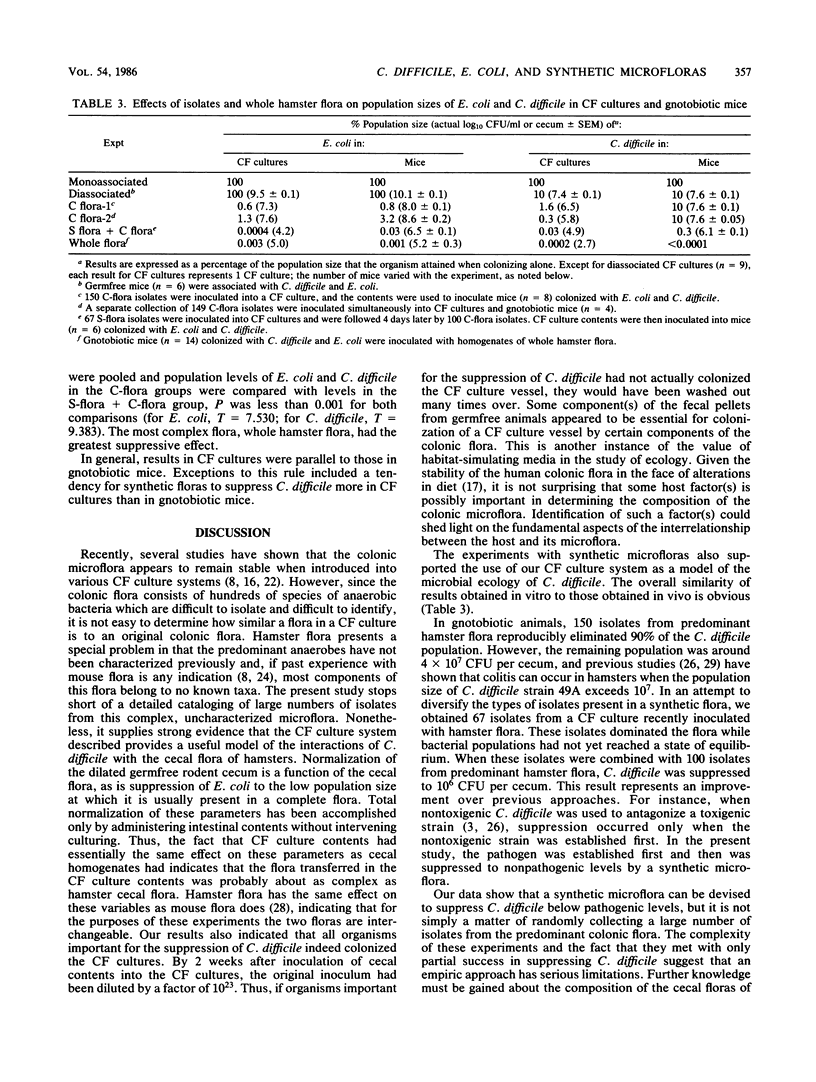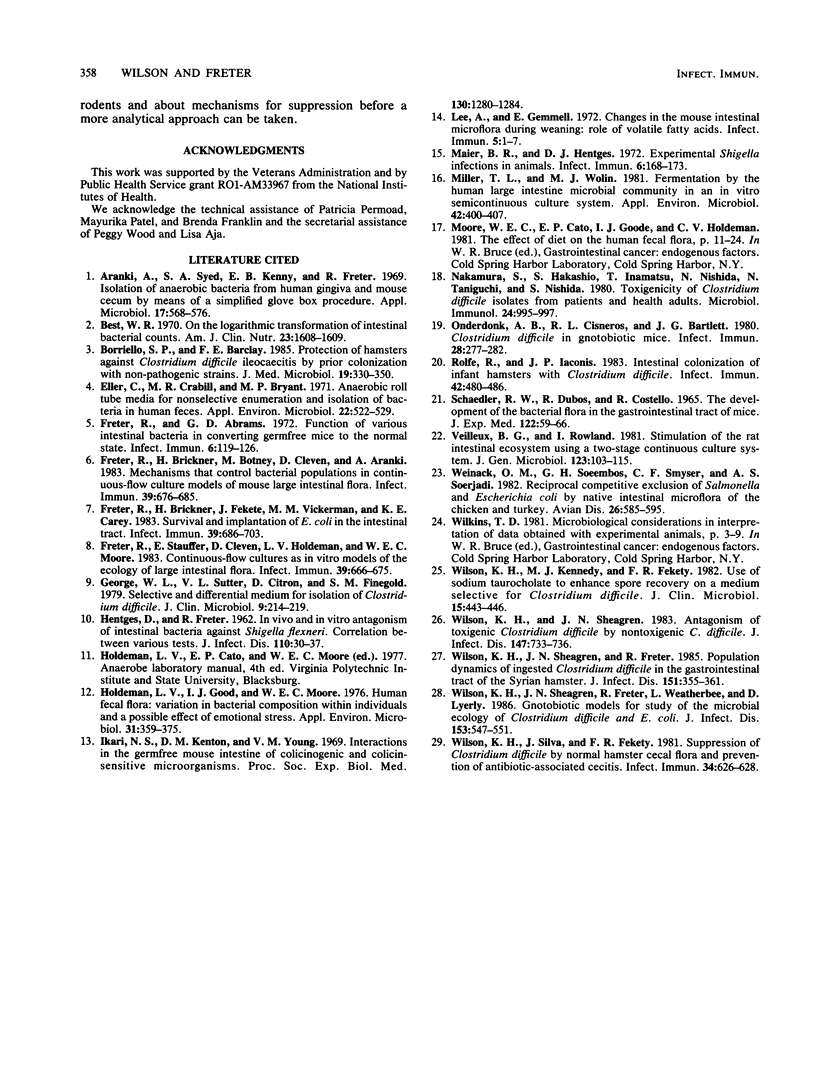Abstract
We studied the interactions between the entire cecal flora of hamsters and the pathogens Clostridium difficile and Escherichia coli in gnotobiotic mice and in a continuous-flow (CF) culture system in which the growth medium consisted of an extract of fecal pellets from germfree mice. CF cultures and germfree mice were colonized first with C. difficile and E. coli and then with the cecal flora of hamsters. Both in vivo and in vitro hamster flora markedly suppressed the potential pathogens. Contents of CF cultures inoculated with hamster flora were introduced into gnotobiotic mice previously colonized with C. difficile and E. coli. These mice were compared with mice given homogenates of hamster ceca. In both groups, the C. difficile population decreased by a factor of more than 10(6) and the E. coli population decreased by a factor of 10(4) to 10(5). CF culture contents also reduced the size of the dilated germfree mouse cecum to normal. When veal infusion broth was used as a medium, contents of CF cultures colonized with hamster flora failed to eliminate C. difficile from mice. Thus, the extract of fecal pellets appeared to contain a substance important for sustained colonization by important components of the cecal flora. We also studied the ability of collections of isolates to suppress the potential pathogens in both gnotobiotic mice and CF cultures. A total of 150 isolates obtained from predominant hamster flora at the ecologic climax stage (C flora) suppressed C. difficile and E. coli to 10 and 1 to 3%, respectively, of the population sizes attained in monoassociated mice. A total of 67 isolates obtained during ecologic succession combined with a C flora consisting of 100 isolates suppressed the potential pathogens to 0.3 and 0.03% of their original levels, respectively. Similar degrees of suppression occurred in CF cultures, further indicating that anaerobic CF cultures are promising models for investigation of the microbial ecology of C. difficile.
Full text
PDF




Selected References
These references are in PubMed. This may not be the complete list of references from this article.
- Arank A., Syed S. A., Kenney E. B., Freter R. Isolation of anaerobic bacteria from human gingiva and mouse cecum by means of a simplified glove box procedure. Appl Microbiol. 1969 Apr;17(4):568–576. doi: 10.1128/am.17.4.568-576.1969. [DOI] [PMC free article] [PubMed] [Google Scholar]
- Best W. R. On the logarithmid transformation of intestinal bacterial counts. Am J Clin Nutr. 1970 Dec;23(12):1608–1609. doi: 10.1093/ajcn/23.12.1608. [DOI] [PubMed] [Google Scholar]
- Borriello S. P., Barclay F. E. Protection of hamsters against Clostridium difficile ileocaecitis by prior colonisation with non-pathogenic strains. J Med Microbiol. 1985 Jun;19(3):339–350. doi: 10.1099/00222615-19-3-339. [DOI] [PubMed] [Google Scholar]
- Eller C., Crabill M. R., Bryant M. P. Anaerobic roll tube media for nonselective enumeration and isolation of bacteria in human feces. Appl Microbiol. 1971 Oct;22(4):522–529. doi: 10.1128/am.22.4.522-529.1971. [DOI] [PMC free article] [PubMed] [Google Scholar]
- Freter R., Abrams G. D. Function of various intestinal bacteria in converting germfree mice to the normal state. Infect Immun. 1972 Aug;6(2):119–126. doi: 10.1128/iai.6.2.119-126.1972. [DOI] [PMC free article] [PubMed] [Google Scholar]
- Freter R., Brickner H., Botney M., Cleven D., Aranki A. Mechanisms that control bacterial populations in continuous-flow culture models of mouse large intestinal flora. Infect Immun. 1983 Feb;39(2):676–685. doi: 10.1128/iai.39.2.676-685.1983. [DOI] [PMC free article] [PubMed] [Google Scholar]
- Freter R., Brickner H., Fekete J., Vickerman M. M., Carey K. E. Survival and implantation of Escherichia coli in the intestinal tract. Infect Immun. 1983 Feb;39(2):686–703. doi: 10.1128/iai.39.2.686-703.1983. [DOI] [PMC free article] [PubMed] [Google Scholar]
- George W. L., Sutter V. L., Citron D., Finegold S. M. Selective and differential medium for isolation of Clostridium difficile. J Clin Microbiol. 1979 Feb;9(2):214–219. doi: 10.1128/jcm.9.2.214-219.1979. [DOI] [PMC free article] [PubMed] [Google Scholar]
- HENTGES D. J., FRETER R. In vivo and in vitro antagonism of intestinal bacteria against Shigella flexneri. I. Correlation between various tests. J Infect Dis. 1962 Jan-Feb;110:30–37. doi: 10.1093/infdis/110.1.30. [DOI] [PubMed] [Google Scholar]
- Holdeman L. V., Good I. J., Moore W. E. Human fecal flora: variation in bacterial composition within individuals and a possible effect of emotional stress. Appl Environ Microbiol. 1976 Mar;31(3):359–375. doi: 10.1128/aem.31.3.359-375.1976. [DOI] [PMC free article] [PubMed] [Google Scholar]
- Ikari N. S., Kenton D. M., Young V. M. Interaction in the germfree mouse intestine of colicinogenic and colicin-sensitive microorganisms. Proc Soc Exp Biol Med. 1969 Apr;130(4):1280–1284. doi: 10.3181/00379727-130-33773. [DOI] [PubMed] [Google Scholar]
- Lee A., Gemmell E. Changes in the mouse intestinal microflora during weaning: role of volatile fatty acids. Infect Immun. 1972 Jan;5(1):1–7. doi: 10.1128/iai.5.1.1-7.1972. [DOI] [PMC free article] [PubMed] [Google Scholar]
- Maier B. R., Hentges D. J. Experimental Shigella infections in laboratory animals. I. Antagonism by human normal flora components in gnotobiotic mice. Infect Immun. 1972 Aug;6(2):168–173. doi: 10.1128/iai.6.2.168-173.1972. [DOI] [PMC free article] [PubMed] [Google Scholar]
- Miller T. L., Wolin M. J. Fermentation by the human large intestine microbial community in an in vitro semicontinuous culture system. Appl Environ Microbiol. 1981 Sep;42(3):400–407. doi: 10.1128/aem.42.3.400-407.1981. [DOI] [PMC free article] [PubMed] [Google Scholar]
- Nakamura S., Nakashio S., Inamatsu T., Nishida N., Taniguchi N., Nishida S. Toxigenicity of Clostridium difficile isolates from patients and healthy adults. Microbiol Immunol. 1980;24(10):995–997. doi: 10.1111/j.1348-0421.1980.tb02904.x. [DOI] [PubMed] [Google Scholar]
- Onderdonk A. B., Cisneros R. L., Bartlett J. G. Clostridium difficile in gnotobiotic mice. Infect Immun. 1980 Apr;28(1):277–282. doi: 10.1128/iai.28.1.277-282.1980. [DOI] [PMC free article] [PubMed] [Google Scholar]
- Rolfe R. D., Iaconis J. P. Intestinal colonization of infant hamsters with Clostridium difficile. Infect Immun. 1983 Nov;42(2):480–486. doi: 10.1128/iai.42.2.480-486.1983. [DOI] [PMC free article] [PubMed] [Google Scholar]
- Veilleux B. G., Rowland I. Simulation of the rat intestinal ecosystem using a two-stage continuous culture system. J Gen Microbiol. 1981 Mar;123(1):103–115. doi: 10.1099/00221287-123-1-103. [DOI] [PubMed] [Google Scholar]
- Weinack O. M., Snoeyenbos G. H., Smyser C. F., Soerjadi A. S. Reciprocal competitive exclusion of salmonella and Escherichia coli by native intestinal microflora of the chicken and turkey. Avian Dis. 1982 Jul-Sep;26(3):585–595. [PubMed] [Google Scholar]
- Wilson K. H., Kennedy M. J., Fekety F. R. Use of sodium taurocholate to enhance spore recovery on a medium selective for Clostridium difficile. J Clin Microbiol. 1982 Mar;15(3):443–446. doi: 10.1128/jcm.15.3.443-446.1982. [DOI] [PMC free article] [PubMed] [Google Scholar]
- Wilson K. H., Sheagren J. N. Antagonism of toxigenic Clostridium difficile by nontoxigenic C. difficile. J Infect Dis. 1983 Apr;147(4):733–736. doi: 10.1093/infdis/147.4.733. [DOI] [PubMed] [Google Scholar]
- Wilson K. H., Sheagren J. N., Freter R. Population dynamics of ingested Clostridium difficile in the gastrointestinal tract of the Syrian hamster. J Infect Dis. 1985 Feb;151(2):355–361. doi: 10.1093/infdis/151.2.355. [DOI] [PubMed] [Google Scholar]
- Wilson K. H., Sheagren J. N., Freter R., Weatherbee L., Lyerly D. Gnotobiotic models for study of the microbial ecology of Clostridium difficile and Escherichia coli. J Infect Dis. 1986 Mar;153(3):547–551. doi: 10.1093/infdis/153.3.547. [DOI] [PubMed] [Google Scholar]
- Wilson K. H., Silva J., Fekety F. R. Suppression of Clostridium difficile by normal hamster cecal flora and prevention of antibiotic-associated cecitis. Infect Immun. 1981 Nov;34(2):626–628. doi: 10.1128/iai.34.2.626-628.1981. [DOI] [PMC free article] [PubMed] [Google Scholar]


